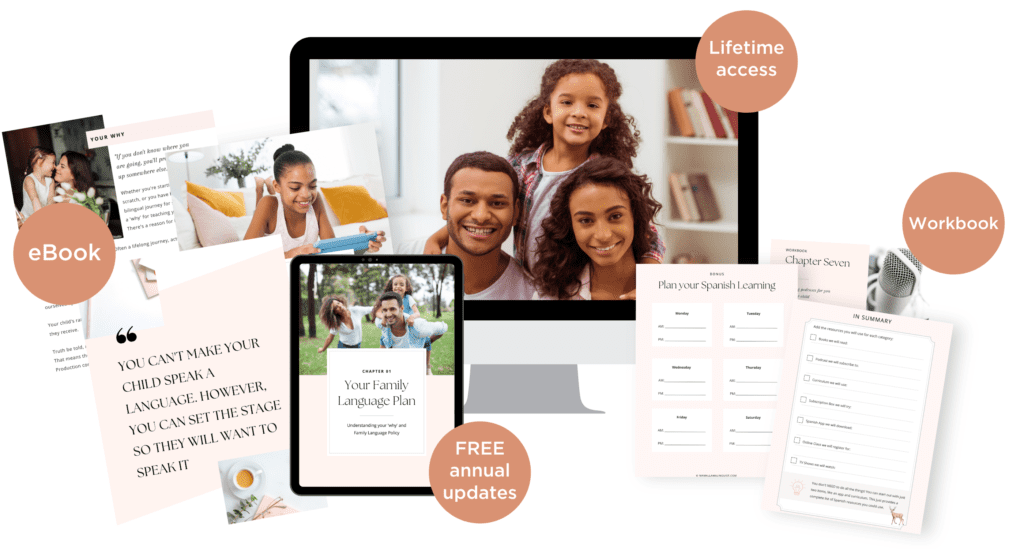In this post: Learn about the most popular strategies for raising a bilingual child and discover which one may be the best fit for your family!
If you are trying to raise a bilingual child, you may have heard that there are a number of different approaches.
Despite many common myths and misconceptions, research has consistently upheld the fact that bilingualism provides several advantages and benefits for individuals and families.
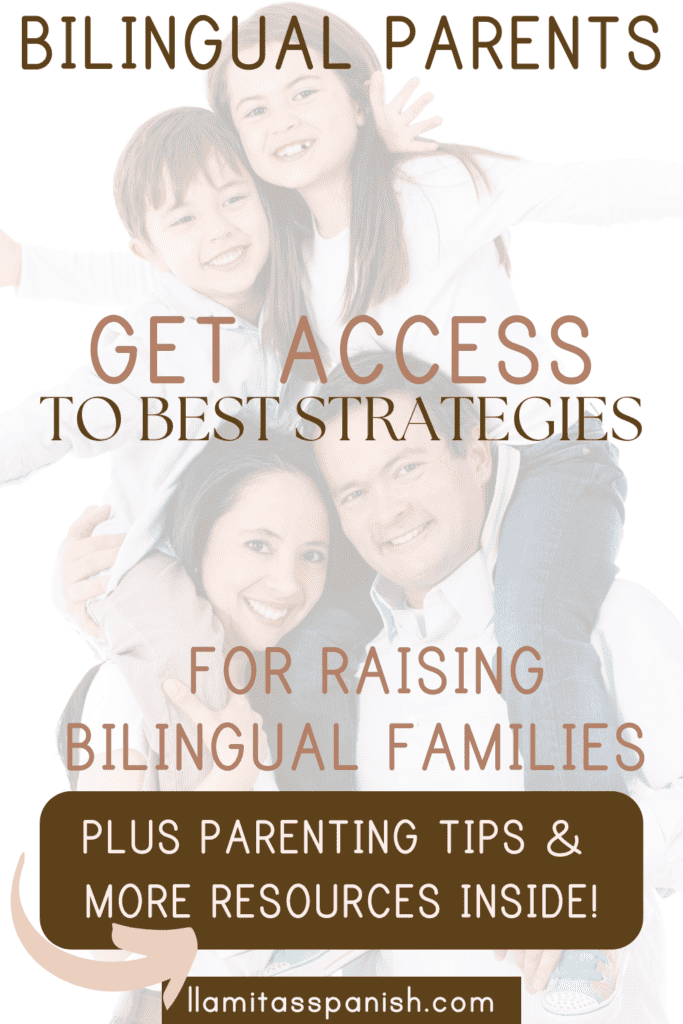
Although raising a bilingual family is highly desirable, it’s not always easy. Using a home-education system such as our Llamitas Spanish Curriculum is a great place to begin, but you will also need to develop some kind of strategy in order to see faster, and longer-lasting results.
The strategy that you and your family use will depend a lot on the adults’ language proficiency and preference. Don’t be afraid to be creative, and see what works best for your family!
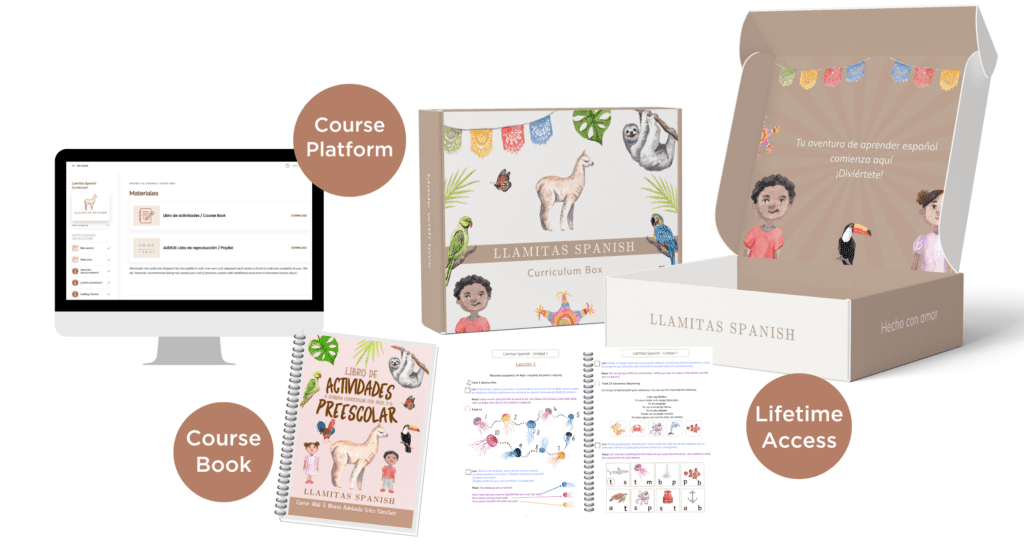
In this post we will discuss some of the most recommended strategies for raising bilingual families.
While these may work very well for some families, they are by no means the only models you can choose to use in your home. In fact, you may choose elements from each and create your own unique way of maintaining and encouraging bilingualism in your home.
Table of Contents
Heritage Language at Home
To simplify matters, let’s refer to our two languages as the “dominant language” (if you live in the US, UK, or Australia, of course this would be English) and “heritage language” (in our case, Spanish). This can also be called ‘Minority Language at Home’.
In families where both parents speak the same heritage language and have a preference for speaking primarily in this language, as in the case of immigrant parents, it’s simple enough to use the “heritage language at home” approach.
This is where everyone speaks Spanish at home, creating a total immersion environment in which the child becomes highly fluent in the heritage language very quickly.
But in modern bilingual society, where parents themselves are fluently bilingual, and many have a preference for bilingual expression, using Spanglish and other forms of dual-language communication, it can be tough to stick to that very singular approach.
And, of course, in families where neither parent is a native Spanish speaker, it may be especially difficult to make Spanish the primary language at home.
Luckily, this is not a requirement, and all varieties of familias have managed to successfully raise bilingual children and create thriving bilingual households. Every familia is unique, and every family’s method of incorporating two languages into the home will be as unique as you are!
Related Post: MLAH Bilingual Parenting Strategy
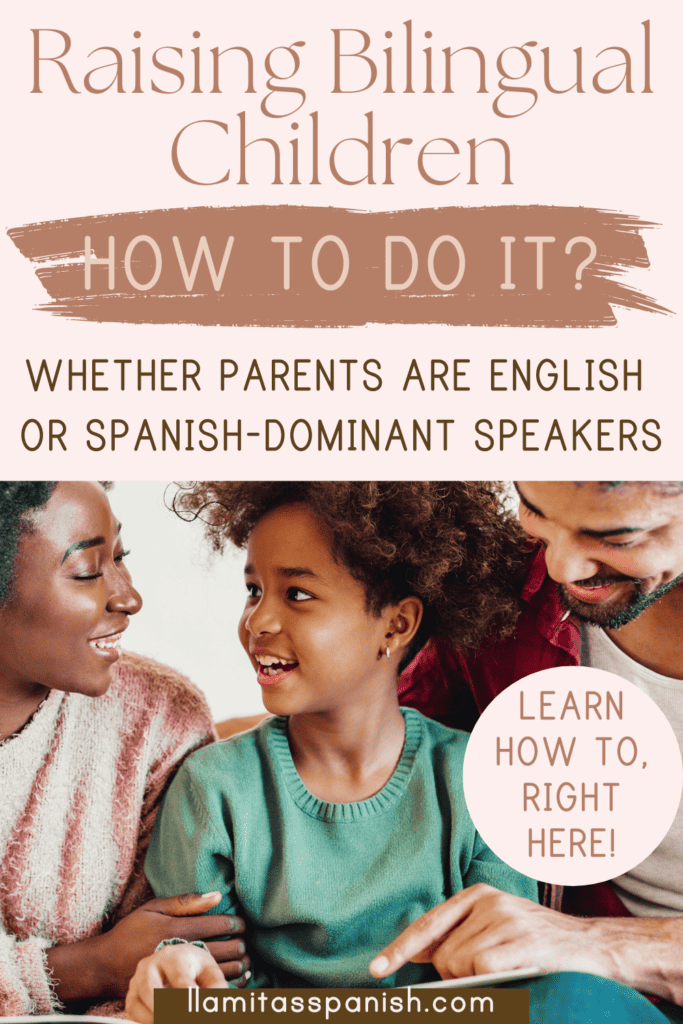
One Parent One Language (OPOL)
In this model, one parent speaks to the child in English, and one speaks to them in Spanish, and this is established as the norm around the house. This approach may work well in some mixed-fluency families, particularly if only one parent is a native speaker of the heritage language, or simply has better fluency in that language.
This method has its advantages when both parents don’t speak both languages with the same fluency. For example, if Mom and Dad both speak Spanish to the child, but one parent speaks it poorly, it can have a detrimental effect on the child’s ability to learn Spanish. So, the “one-parent-one-language” method would be ideal in those circumstances.
This model is also useful for parents who speak an additional language besides English. For example, if one parent speaks Spanish to the child and one speaks Portuguese, the child will come to associate each parent with their native or fluent language, and in these cases, the children grow up trilingual!
If both parents are also fluent in English, you may decide to use English with your kids when you go out. Kids will also naturally learn English at school and through general immersion in the dominant English-speaking culture.
Related Post: A Bilingual Parenting Success Story with Adam Beck
Time and Place Method
This approach involves setting aside periods of time during the day in which the target or heritage language will be used. For example, some families choose to use Spanish at meal times. Others may set aside a period of time during the day to listen to Spanish songs, watch Spanish programs or videos, or read Spanish books or poems together.
We’ve compiled a great list of Spanish-language learning resources that you can use to this end.
This method works in households where families are well-organized around scheduling. In homes where things are less organized, this method may not work as well, because the “Spanish time” may begin to fall through the cracks of daily chores and activities if strict adherence to the schedule is not maintained.
Many immigrant families use this approach, wherein children know, for example, that they must revert to Spanish automatically when visiting Abuela’s house, or when speaking to certain family members or caregivers, or at family gatherings or church events.
The shortcomings of this approach are that the conversations the child may engage in may be limited by the limited context in which they occur.
In many cases, children raised using this method grow up speaking only “household Spanish” that they learned from their abuelitos, and may feel awkward as they get older when speaking Spanish in circumstances outside the home, such as school or work.
Unstructured bilingual time
This method of simply modeling bilingualism and encouraging bilingualism as a lifestyle through your own behavior has the advantage of bypassing schedules, rules, and/or the sense that a child is being “forced” to speak a particular language.
In this approach, parents may suddenly switch the conversation to Spanish, or put on Spanish music while doing another activity, and begin singing along in Spanish. This method is actually the one most often used in bicultural families, and although it may not be perfect, it has worked for thousands of families who have raised kids in this way.
With this method, the child may not even be consciously aware that they’re growing up in two languages up until about the age of 3 or 4, or when they begin to attend school outside the home. Over time, they will sort out the two languages, but there may be a period of mixing between languages as they develop this skill.
Mixed Language Strategy
This approach can be a little tricky, because the child will naturally default to the language they prefer, which will almost always be the dominant language spoken by peers at school, and not the heritage language that you want them to practice.
While this may be the easiest method, it is definitely the least efficient, because the child won’t be pushed to express their ideas in the heritage language, resorting always to their comfort zone. This may cause them to delay mastering the heritage language and, in some cases, the child may never master the language fully.
In short, there is no ideal or perfect way to establish and nurture a bilingual household, and you’re welcome to try any of the above approaches, or a combination of one or two. You can always change things up if it looks like you’re not getting the results you want.
But one thing is certain: your child’s proficiency in Spanish will improve as you make available more and more resources that help the child to obtain more exposure to the Spanish language.
Higher quality exposure can be achieved through top-quality materials, and more interesting engagement with the language by including interactive playtime activities in Spanish.
By supplementing our Spanish Curriculum levels with fun-filled educational resources and activities such as our Seasonal Bundles, you can make your home an ideal environment for an enhanced language-learning experience and help your children to develop a love for the Spanish language that they will carry throughout their entire lives!
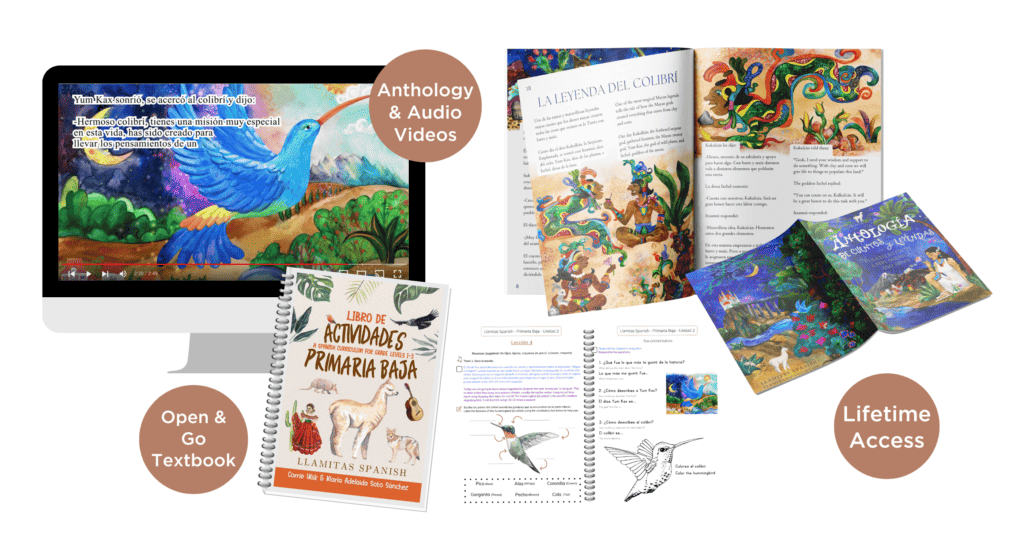
The Ultimate Guide to Raising a Bilingual Child
If you are ready for a DEEP DIVE into creating a bilingual parenting plan that is perfect for your family, my eBook & workbook bundle: Learn Spanish en Casa is a step-by-step guide that will get you on the path to bilingual parenting success!
With hundreds of resource recommendations, from podcasts to books, music to media and a complete workbook to help you take action ~ it is the BEST guide for establishing a family language plan!
You can check it out in the Llamitas Spanish Shop and use code LLAMITAS for 10% off.
